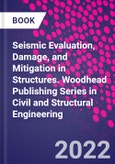Seismic Evaluation, Damage, and Mitigation in Structures covers recent developments in the field of seismic performance assessment of structures. Earthquakes are one of the main natural hazards that can directly cause damage to a structure or even instigate a structural collapse, resulting in significant economic and human loss of life. In the event of an earthquake where many buildings and infrastructure components are not able to function afterward, or if extensive repair and associated disruption are needed, it can be extremely costly and take a long time to resolve.
Divided into three parts, this book reviews and discusses earthquake-induced damage evaluation in structures, the repair of structural and non-structural components, and seismic damage mitigation strategies. With contributions from the leading experts in the field, this book is for earthquake engineers, structural engineers, PhD students studying civil engineering, people who can easily inspect and repair structures for quick reoccupation, and for those who understand topics such as design and damage mitigation, and limited structural or non-structural damage in seismic events.
Please Note: This is an On Demand product, delivery may take up to 11 working days after payment has been received.
Table of Contents
PART 1 Introduction, earthquake-induced damage evaluation and repairs in structures
1. Damage indexes for performance assessment of low-rise RC walls
2. Controlling the deflection of long beams using pre-tensioning cables
3. Cable-Cylinder Bracing System: Theoretical Background, Structural Behaviour and Seismic Design Coefficients
4. Method of seismic resistance design
Case studies
5. Probabilistic evaluation of earthquake-induced damage
6. Novel technique of seismic resistance design
7. Development and application of Bouc-Wen model in seismic performance evaluation of reinforced concrete members
PART 2 Repair of structural and non-structural components
8. Developing Seismic Fragility Curves for Caisson-type Quay Walls with Improved Backfill Soil
PART 3 Seismic damage mitigation strategies
9. Machine learning for seismic assessment
10. Robust design of intelligent control systems to mitigate earthquake-induced vibrations under uncertain conditions
11. Multi-Story Buildings Equipped with Innovative Structural Seismic Shear Fuse Systems
12. Seismic protection strategies for damage mitigation in structures
13. Measures to mitigate seismic risks
14. Mitigation of Deformations of a Hunchbacked Block-type Gravity Quay Wall Subjected to Dynamic Loading through Optimizing its Back-face Configuration
15. Other methods of seismic damage mitigation strategies
Authors
Iman Mansouri Associate Professor, Department of Civil Engineering, Birjand University of Technology, Iran. Iman Mansouri received his Ph.D. degree from the Department of Civil Engineering at the Shahid Bahonar University of Kerman. He ranked first in all his previous academic degrees. Currently, he has been an Associate Professor at the Department of Civil Engineering, Birjand University of Technology. He has many collaborations with researchers around the world (e.g., the U.S., Japan, Spain, Canada, South Korea, Nigeria, and China). He is a member of the Editorial Committee of KSCE Journal of Civil Engineering, an International journal having a JCR index. His research interests are in the area of nonlinear structural analysis, earthquake engineering, seismic retrofitting, performance-based design, and soft computing methods. Paul O. Awoyera Associate Professor, Department of Civil Engineering, Prince Mohammad bin Fahd University, Dhahran, Saudi Arabia. Paul Awoyera is an Associate Professor and a Researcher in the areas of concrete structures, structural retrofitting, sustainable/innovative construction materials, fire resistance, non-destructive testing, data science, and applied Artificial Intelligence. He has over 12 years of experience in structural engineering consulting, teaching, and research. He obtained his PhD Degree in Civil Engineering from Covenant University, Nigeria.Dr. Awoyera completed a one-year Post-Doctoral research, focusing on lightweight composite development using paper and ceramic wastes, at the University of KwaZulu-Natal, Durban, South Africa. He was awarded the prestigious Split-Site PhD Scholarship by the Commonwealth Scholarship Commission in the United Kingdom, which was tenable at the University of Nottingham, United Kingdom.
Dr. Awoyera is a registered engineer with the Council for the Regulation of Engineering in Nigeria (COREN), a member of the International Association for Engineers (IAENG), and a corporate member of the Nigeria Society of Engineers(NSE). He has published over 100 articles in leading publishing outlets and served as the editor/editorial board member and reviewer for numerous international journals.








